Pipe Fittings are defined as the piping components that help in pipe routing for directional changes, size changes, and branch connections. Piping Elbows, Piping Reducers, Tee Connections, Olet Connections, Caps, Crosses, etc are pipe fittings and are widely used in both the piping and plumbing industries. Different pipe fittings serve different functions as per layout or process requirements. Pipe fittings are manufactured as separate items and procured separately. Pipe fittings are connected to piping using various end connections. Pipe fittings play an important role in the proper functioning of pipes and tubes in various applications. In this article, we will study the overview of different types of pipe fittings used in the piping, pipeline, and plumbing industry.
Types of Pipe Fittings
Various types of pipe fitting are used in piping, plumbing, and pipeline industries to serve as branch connections or other inline piping components. Common Pipe Fittings that are widely used in industries are listed below.
- Piping Elbow
- 900 Elbow (direction change by 90 degrees)
- 450 Elbow (direction change by 45 degrees)
- Long Radius Elbow (bend radius is 1.5 times of pipe diameter)
- Short Radius Elbow (bend radius is 1.0 times pipe diameter)
- Tee-Connection
- Equal Tee
- Reducing Tee
- Barred Tee
- Reducer
- Concentric Reducer
- Eccentric Reducer
- Pipe Unions
- Coupling
- Half Coupling
- Full Coupling
- Reducing Coupling
- Adapters
- Olet-Connections
- Piping Valves
- Cross
- Equal Cross
- Reducing Cross
- Wyes
- Pipe Cap
- Nipples
- Plug
- Bushing
- Pipe Flanges
- Expansion Joint
- Steam Traps
- Long Radius Bend
- 3-D Bends
- 5-D Bends
- Barb
- Locknut
- Miter Bend
- Collar
- Gaskets
However, note that if a pipe or pipeline is bent at a pipe fabrication shop to change the direction it is not a pipe fitting. Pipe fittings are always separate items from the pipe. Click on the Bold and italics words above to know about those items in detail as I had already published separate articles on those. We will discuss the remaining pipe fittings in the next paragraphs.
The following image (Fig. 1) shows various types of fittings for reference.
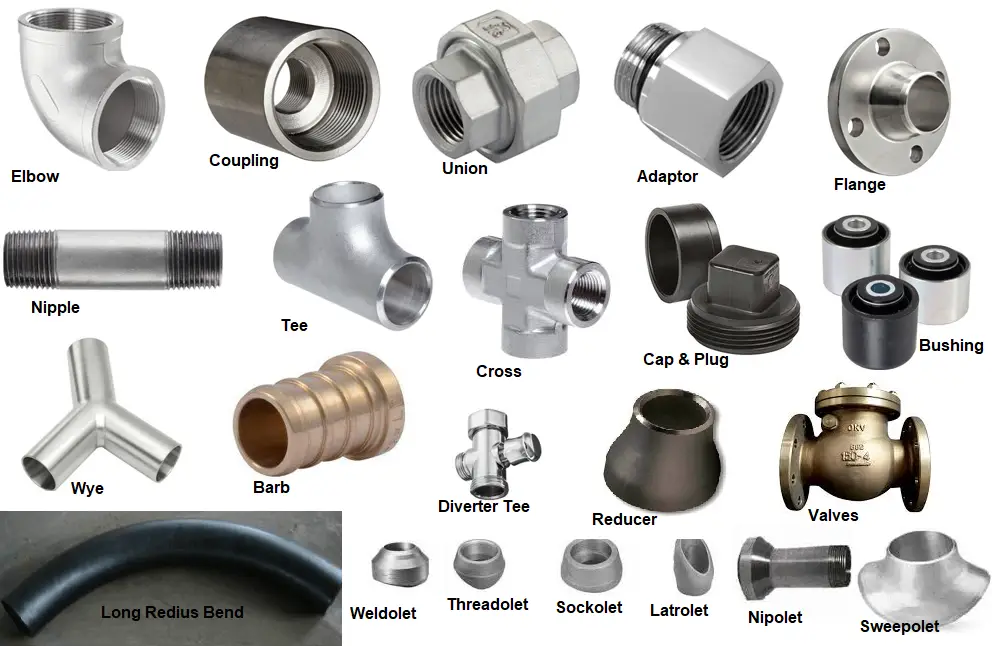
Pipe Union/Pipe Fitting Union/Pipe Union Fitting
Pipe Union is a special type of pipe fitting that unites two pipes and can be easily detached without any deformation to the pipes. They provide a positive seal and easy assembly as well as disassembly. In pipe fitting applications, They are widely used mainly for small bore piping and plumbing industries. Pipe unions are made of Carbon steel, Stainless steel, Cast iron, Copper, Nickel, Aluminum, Plastic, and Alloy materials depending on temperature, and service requirements.
A pipe union has three parts; A male end, A nut, and a female end. The female end has threads on the inside whereas threads are outside on the male end part. The nut provides the necessary pressure and seals the joint. Fig. 2 represents typical pipe unions used in the pipe fitting industry.
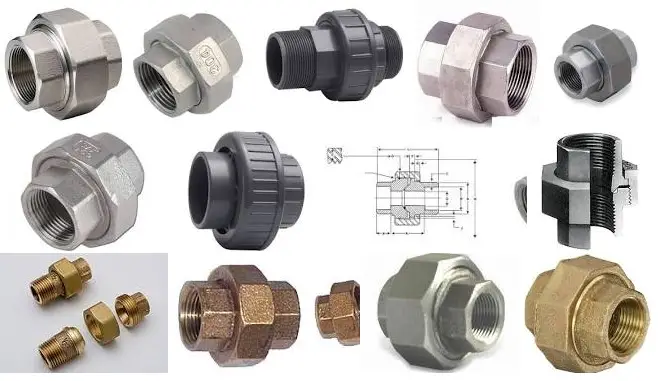
Pipe Adapters
Adapters as pipe fittings are used to connect dissimilar pipes. Pipe adapters are available in various types for different applications. So care must be exercised while ordering to get the right type. They are classified as Locking Pipe Adapters, Offset Pipe Adapters, Male Pipe Adapters, Female pipe Adapters, Straight Thread adapters, etc. They find their majority of applications in sanitary pipes for plumbing applications. Normally they are made of Steel, Cast iron, polymers, Brass, Aluminum, Bronze, and copper materials.

Pipe Olet Connections
Piping Olet is a self-reinforced branch connection used to connect small pipe branches from larger size main pipes. This is an alternative to a pipe to pipe branching. They are specially designed by a company called Bonney Forge. In places where the reducing tee is not available, piping olets are widely used. Piping olets are designed based on MSS SP-97 or ASME B31.3. Different types of piping olets are available. Widely used piping olets are:
Weldolet: It’s a 900 branch connection and is available for 2″ and more sizes. Weldolet pipe fittings are suitable for high-temperature and pressure classes and are widely used in the piping industry. Weldolets are available in two sizes; full size and reduced size. However, Reducing size is the most widely used weldolet.
Sockolet: Sockolets are also 900 branch connections but they are used to connect small-bore socket-welded piping to larger-size Butt-welded Piping headers. Similar to weldolet, they too, come in full-size and reducing-size constructions.
Thredolet: Threadolets are 900 pipes fitting suitable to connect small-bore threaded fittings to Buttwelding Piping Connections.
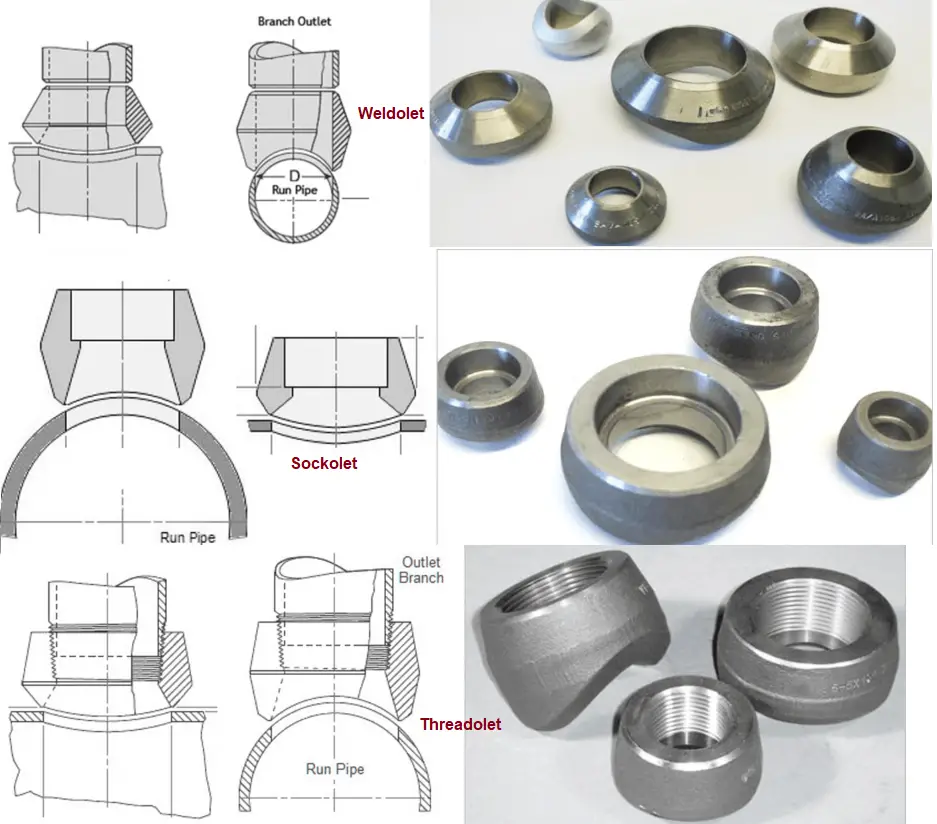
Similarly, there are other pipe olet fittings like Elbolet, Nipolet, Latrolet, Flexolet, Flangolet, Sweepolet, and Coupolet. Their pictorial representation is provided in Fig. 5.
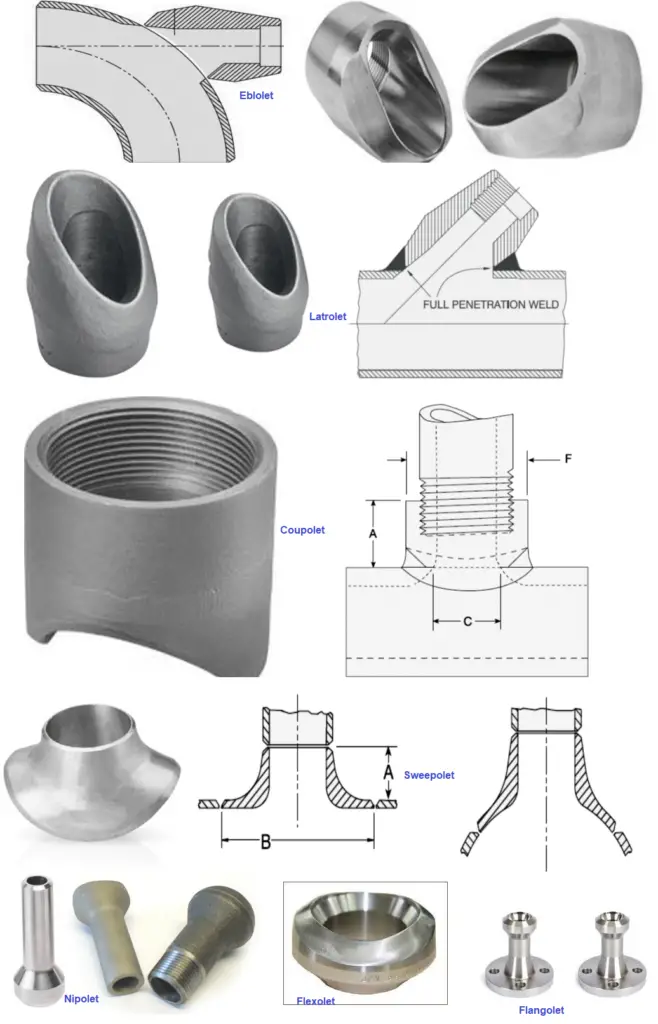
Piping Cross
A piping cross is also popular as a four-way pipe fitting as it consists of one inlet and three outlet connections or vice versa. They are not that popular in the oil and gas industries and are seldom used. They are used in fire sprinkler systems. In piping crosses, four piping connections meet at one common point.
Wyes
Wye pipe fittings are also called lateral connections. the name wye came because it resembles the letter “Y”. Such types of pipe fittings are used in drainage systems and have a branch line at 45 degrees to keep the flow of water smooth. This kind of pipe fitting has a low frictional loss and very low turbulence.

Caps and Plugs
Pipe Caps and Plugs are pipe fittings that are used to close the piping ends. They cover the piping ends and provide a tight seal. They are widely used in pipe dead ends or at future connections.
Bushing
Bushings as pipe fittings combine different pipe sizes together. They decrease the larger size to the size of the smaller pipe. In comparison to a union or coupling, Bushings occupy very little space.
Long Radius Bend
Long-radius pipe bends are used in fluid transportation pipelines requiring pigging. Such pipe fittings have very less pressure drop and smooth flow due to their long radius and smooth direction change. Common long-radius pipe bends are 3D and 5D Pipe bends where D is the pipe size.
Barb
A barb is a useful pipe fitting used in the plumbing system. Barbs connect the flexible tubing to the pipes. They have a male-threaded end on one side and the other end has a single or multi-barbed tube that is inserted in the flexible tubing.
Collar
When joining two plumbing pipes of the same diameter, a collar can be used. It is fitted at the end of the pipe.
Pipe Fittings Types Based on Uses/Purposes
Depending on the use of pipe fitting, they can be classified as follows:
- Pipe fitting types to extend or terminate pipe runs
- Couplings
- Adapters
- Unions
- Caps
- Plugs
- Pipe Fittings for Direction Change
- Elbows
- Bends
- Tee-Connection
- Cross
- Pipe fitting types to connect two or more pipes
- Tees
- Cross
- Side-inlet Elbows
- Wyes
- Pipe fittings for size change
- Reducers
- Bushings
- Couplings
- Reducing Tee
- Pipe fittings for flow control
- Valves
Pipe Fittings Selection Criteria
Various factors need to be considered for selecting proper pipe fittings. A few of them are listed below for reference:
- Materials of construction: Pipe fitting material must be compatible with the service and temperature. Normally the material selected is the same as pipe material.
- End Connection types: The buyer must be aware of the end connection types before purchasing any pipe fitting.
- Type of pipe fitting: Pipe fittings are also identified by the type of fitting like threaded or slip, male or female. So, it’s the buyer’s responsibility to choose the correct pipe fitting type.
- Pipe Fitting Size: The size of the fitting must be known prior to the selection of the fitting. Normally, the OD or ID of the connecting pipe decides the pipe fitting size.
- Schedule or Thickness: Pipe fittings are also available at various thickness ranges similar to a pipe. So, before pipe fitting selection, the thickness must be ensured.
- Pressure Rating: Internal pressure is also an important factor for proper pipe fitting selection.
- Pipe Fitting Standards and Codes: Various codes and standards are available for pipe fittings. The buyer should select the correct one before placing the order. For example, ASTM, ASME, DIN, BSP, MSS, ISO, etc. are certain standards assigned to pipe fittings and those standards govern their design and use.
Purpose of a Pipe Fitting
Pipe fittings serve any or more of the following purposes:
- Changing the direction of fluid flow (Elbow, Tee, Cross, Bend, etc)
- Connecting two or more pipes of the same or different size (Cross, Tee, Wye, etc)
- Connecting pipe size (Reducers, Couplings, Reducing Tee, Bushings, etc).
- Connecting a pipe to equipment nozzle/Instrument/Special Item/Strainer (Valve, Flanges, etc).
- Sealing a Pipe( Blind flange, Caps, Plugs, Adaptors, Unions)
- Maintaining or regulating the flow (Valves)
Pipe Fitting Standards
Pipe Fittings are dictated by the following codes and standards:
- ASME B16.9
- ASME B16.28
- ASME B16.11
- ASME B16.1
- ASME B16.3
- ASME B16.4
- ASME B16.5
- ASME B16.14
- ASME B16.15
- ASME B16.25
- ASME B16.36
Pipe Fitting Materials
Various materials from which pipe fittings are manufactured are:
- Carbon Steel: A-105; A-234; A-216
- Stainless Steel: A-182; A-403; A-351
- Low Alloy Steel: A-182; A-234; A-217
- LTCS: A-350; A-420; A-352
- Nickel and Nickel Alloys
- Chrome-molybdenum
- Aluminum
- Titanium
- Bronze
- Brass
- CPVC
- EPDM
- Fiberglass / Composite
- Iron (Gray / Cast/ Ductile)
- Elastomer
- Neoprene
- Nylon
- Polyamide
- Polyethylene (PE)
- Polypropylene (PP)
- PTFE
- PVC (Polyvinyl Chloride)
Applications of Pipe Fittings
Pipe fittings are highly popular and widely used in the following industries:
- Refinery/Chemical/Petrochemical
- Municipal
- Power
- Oil and Gas
- Food, Beverage, and Dairy
- Process Instrumentation
- Pulp and Paper
- Semiconductor
- Steel
- Marine & dredging
- Irrigation
- Residential
- Sanitation
- Road & highway construction
- Ventilation etc.
Online Video Course on Piping and Pipe Fittings
To enrich yourself with piping and pipe fitting details you can opt for the following online video courses


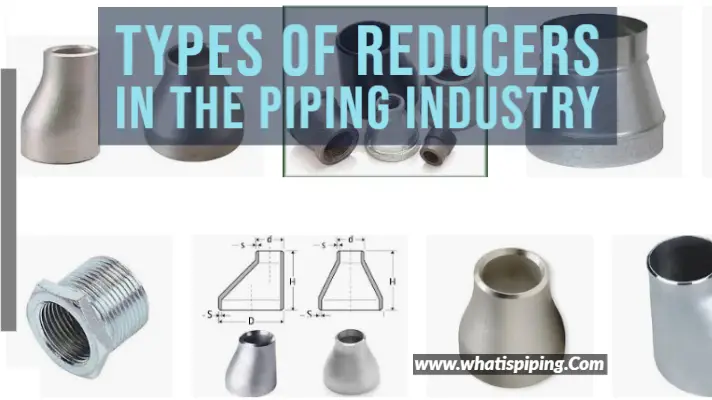

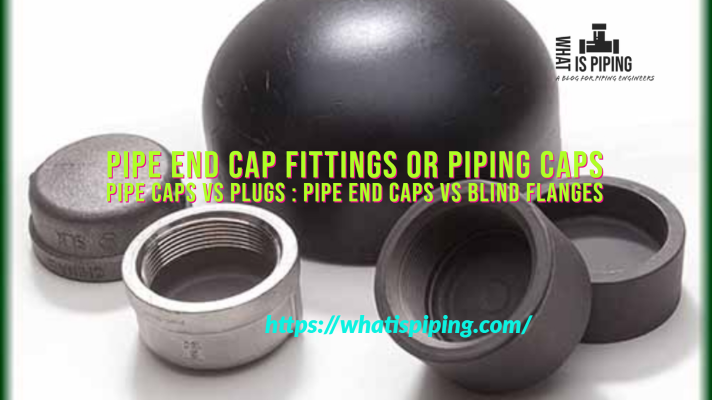


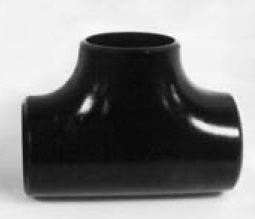
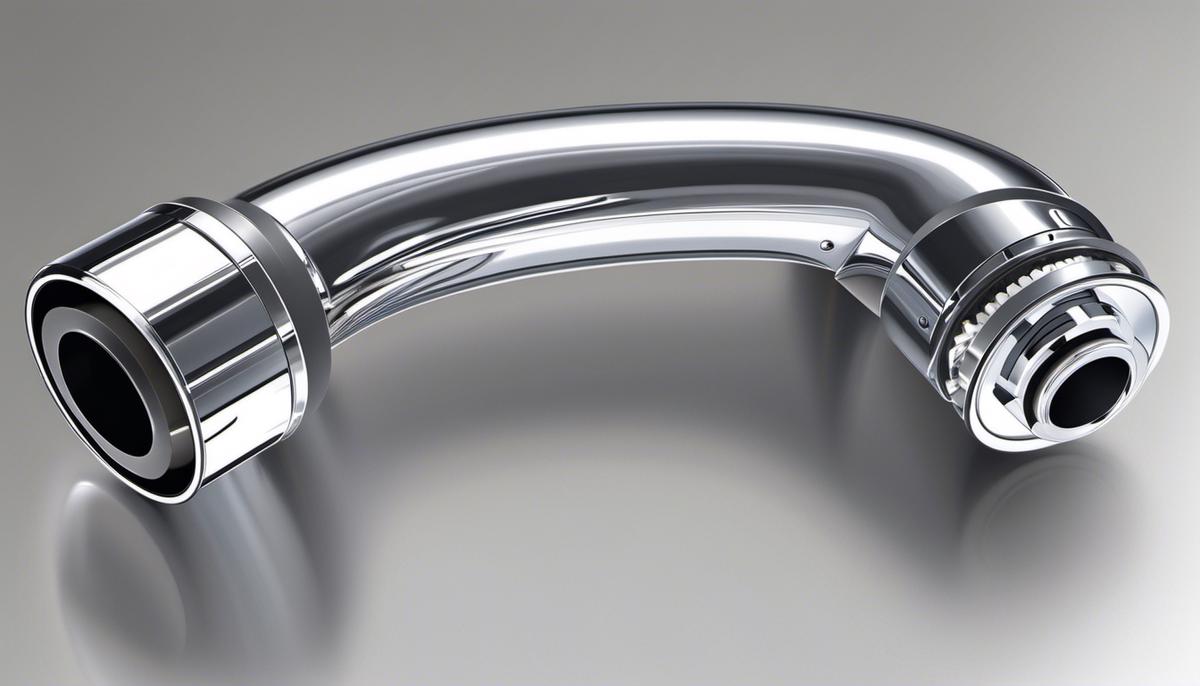
I really proude off you dear sir
Thank you Mr Anup Kumar Dey for your blogging. It provides enlightenment to the public domain , God bless you and give you more knowledge for your good work .
Thank you Sir for this knowledgeable study material
It’s wonderful to know that there is a pipe fitting that can unite two pipes and can be easily detached without causing deformation where it is called Pipe Union. Moreover, it produces a positive seal and easy to be assembled and disassembled. I would like to think if someone needs a pipe fitting, he should go with this type as it is very easy to unite pipes and provide a positive seal.
Awesome
It’s good to know that carbon steel fittings are quite commonly used for construction. I’m thinking about starting to learn more about materials used for construction in order to be more aware of the processes involved in building my dream home. That way, I wouldn’t feel too lost when working with a manufacturing company for the building materials.
There are wide range of pipe fittings that are used in plumbing application, these include; adapter, elbow, nipple, valve, union, wye, cap and plug, cross, coupling, barb, tee and mechanical sleeve etc.
Thanks for the notes,,, it really assist in a wide range of courses so as to me as a biomedical engineer it has really help so much
Hello sir’
Techno engineering
Thanks a lot for the useful information.
the one place where we can get the summarized information of any topic.
it clearly shows the amount of background work done to publish the information.
KUDOS sir
Good day Sir,
I am Christopher Raju having mechanical degree with 8 plus experience in piping field , now I got job in teaching faculty in one of the instition in my state
So can you give any study materials related to piping engg . which may have help in my reference for in deep
Looking forward to hear from you,
yaa!!!Realy I proud on you.
What an incredibly thorough and informative article on the different types of pipe fittings and components for the piping, pipeline, and plumbing industry! As someone who is interested in these fields, I found your post to be really helpful in understanding the various types of fittings and their uses.
I appreciated how you explained each type of fitting in detail and provided examples of their applications. Your descriptions were clear and easy to understand, even for someone who doesn’t have a lot of technical knowledge in this area.
I also liked that you included information on the different materials used for pipe fittings and their advantages and disadvantages. This is something that I’ve always been curious about, and your explanations were really helpful in understanding the differences between materials like PVC, copper, and stainless steel.
Overall, this was a great resource for anyone who wants to learn more about pipe fittings and components for the piping, pipeline, and plumbing industry. Thank you for sharing your expertise!
Excellent article explaining the various types of pipe fittings! The comprehensive breakdown of different fittings, along with their applications and advantages, is incredibly helpful for both beginners and professionals in the field. The inclusion of clear diagrams further enhances the understanding of each fitting type. I appreciate the effort put into making this information easily accessible and well-presented. This article is a valuable resource for anyone seeking to expand their knowledge of pipe fittings. Great job!
Tnxs for your content